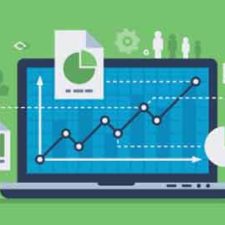In order to gain an overall idea about any subject, we must always begin from its basics. So, to find out the answer to the question, “what is actually Statistics?” we need to start from its very beginning.
Typically, Statistics is a branch of Mathematics.
It is a procedure, where raw data is converted into information that is not just comprehensible by the people but is usable for them. In other words, one can say that statistics is an accumulation of those tools that aim to make people understand the concept of quantitative data. And at the same time, it also explains the meaning of such data.
Furthermore, these tools may also seek to compare various datasets to find out the similarities among them and how interdependent are they in practice. They may also be used to pinpoint the characteristics of any given data or inference.
As per the Journal of Statistical Society of London, May 1838, “The science of statistics differs from political economy, because, although it has the same end in view, it does not discuss causes, nor reason upon probable effects; it seeks only to collect, arrange, and compare, that class of facts which alone can form the basis of correct conclusions with respect to social and political government.”
Fields like including economics, biology, marketing, advertising and medicine rely heavily on statistics for a number of purposes. Those who deal with statistics on a regular basis and use it to formulate, accumulate and interpret data in various fields are called statisticians
A Brief History of Statistics
The word statistics is derived from the German word ‘staat’ and tends to signify a state or group of beings existing in any social union. As per Francis Bisset Hawkins, a renowned English physician, the word ‘statistics’ was used for the first time in the middle of the 18th century by a Gottingen professor named Achenwall. It is said that Achenwall used the word to explain and summarise the conditions of the states in terms of physical, moral and political parameters.
Branches of Statistics
- Descriptive Statistics:
As the name suggests, thisparticular branch uses graphs, charts, tables and numerical calculations to describe a sample population.
It is further divided into measures of central tendency and measures of variability. While the former includes Mean, Median and Mode, the latter includes Minimum and Maximum Variable, Variance, Standard Deviation, and Kurtosis and Skewness.
- Inferential Statistics:
The word inference means to interpret or conclude. This said branch of statistics uses a random sample of data of a given population to describe and make predictions about the sample population.
It is also divided into two types, namely estimating parameters and hypothesis testing.
Why Study Statistics?
The chief economist of Google, Hal Varian, believed in 2009, “The sexy job in the next ten years will be statisticians. Because now we really do have essentially free and ubiquitous data. So the complimentary factor is the ability to understand that data and extract value from it.”
Ten years later, the scenario is actually how he had predicted.
Be it medical studies, research, experiments, social sciences, communication, networking or scientific discoveries, a large number of data is being collected at every second in every corner of the world. Having a general knowledge of the subject serves as the perfect tool to extract and interpret useful information from accumulated data. It also helps to find out which data is practical and serves logic.
Other than this, here is a list of reasons that tells us in brief why one should study statistics-
- For research
To begin with, one needs to study statistics to be able to conduct research effectively. Without the knowledge of how statistics are used, it will be quite difficult to decipher the accumulated data and arrive at feasible conclusions. Statistics serve as a tool that helps us to make polished and sensible inferences.
- For understanding technical explanations
Next, it can be said that studying statistics tend to come in handy when one reads through technical journals. The thing about such journals is that they often contain statistics in some form or the other. Being familiar with the subject will help you not just to read the journal but to actually understand the concept and to apply it in practice effectively.
- To develop critical thinking
Studying statistics helps one inculcate analytical skills and sharpen their critical thinking. Having a sound analytical skill further helps to think logically and differentiate between principles that are feasible and the ones that cannot be practised in real-time scenarios.
- To become more informed
Lastly, it needs to be said that statistics is a tool and is prone to be misused. When a person studies statistics, they are more likely to identify useful statistics from misleading ones. Someone familiar with the concepts of statistics will be able to understand if they are being fooled on purpose or not. This directly makes one more informed and alert as a consumer.
The Basic Criteria to Study Statistics
In the statistics curriculum, one is introduced with the concepts of mathematics, logic, statistical reasoning, data evaluation and analysis, and research methods. In order to be able to grasp such concepts at a go, an aspirant student is expected to have a background in either maths or statistics.
Students, who want to take up statistics for their master course in the US, should have obtained a bachelor’s degree in statistics from a reputed institution. Those who want to seek admission in doctoral courses should be having degrees like M.stat, M.Sc in Statistics from a famed institution.
Here is a list of basic skills that are required for taking up Statistics-
- Since statistics is a branch of maths, having a strong understanding of maths, its concepts and their applications come in handy for studying statistics.
- Possessing a strong understanding of the basic functioning of statistics is a great advantage for students who wish to take up statistics; it will prove to be helpful for understanding the concepts of the subjects better.
- The ability to think logically and to analyse the facts available at hands if an added bonus for those who want to take up statistics. Since the subject deals with a lot of analysis and logical reasoning.
- Having a sound comprehension skillis important to understand how inferences are drawn from data and applied into practice. This makes studying statistics easier.
- Possessing a sound problem-solving skill and good people skills helps to interact with people better. It also allows one to offer solutions to people with different temperament and understanding in various situations, which is quite helpful in the field of statistics.
- The urge to be up to date with the latest statistical journals, software and tools also prove to be of great help. Someone who is well aware of the things that are going on in their field of study not only gives them the idea of how things function in their chosen field but also allows them to get the hang of it quickly.
So, in the case you wish to take up Statistics in college or university, make sure that you are not just well-versed with numbers and concepts of Mathematics but also have strong analytical skill. The best thing that you can do now is to make sure to get all your doubts cleared about the basic concepts of both maths and statistics. Doing so will help you to excel at the subject and will also help you to shape a great career out of it.
Career and Opportunities
The American Statistical Association had predicted, “The demand for statisticians is currently high and growing. According to the Occupational Outlook Handbook, published by the Bureau of Labor Statistics, the number of non-academic jobs for statisticians is expected to increase through 2016.”
In April 2019, USA Today ranked statistician as number 5 on the list of top jobs in the United States of America. On the basis of the ranking, one can safely say that the prediction made by the American Statistical Association is 100 percent accurate. The daily newspaper further stated that a good work environment; low stress at work and good projected employment growth makes it one the rare careers to score high in the three categories.
This has further spiked the demand for professional statisticians and offered the practitioners with several lucrative job opportunities. Given the recent developments, it is expected that the demand for the job will increase by 34% in the next seven years.
Why Statisticians are in Huge Demand?
As the number of available data and the ease to access it increases, the demand for experts who can explain the meaning behind data has also increased. Moreover, the adoption and utilisation of statistics in various fields including, social science, physical science, business, industry, journalism, agriculture and government have further pushed the demand for pure statistics upwards.
Typically, statisticians are in huge demand owing to these following reasons-
- They help companies to bring down their cost.
- They tend to optimize different processes and to speed them up.
- They make data-driven decisions, which are more likely to be effective.
- They help to understand the market demand and its inclination.
- They assist in designing clinical trials.
The benefits that companies and institutions have availed by employing statisticians speak can be witnessed in their recent performances. The willingness to include data analytics into the system of decision-making has made the statisticians so appealing to the companies and other big recruiters.
Things to Remember about Statistics
Statistics is beyond description and testing. Through statistics, one cannot only describe, compare and test data but also identify, classify, predict and explain them to others.
- When it comes to statistics, everything is uncertain. The so-called ‘input data’ tend to vary; therefore, the results are mostly expressed as a probability. The reason behind variations being, the presence of ‘n’ number of causes most of which are often uncontrollable or unpredictable.
- In statistics, models serve the purpose of both input and output analyses. With the help of statistical techniques, one can build a model from any given data. Through the use of distribution models, statistics can describe the data frequency of an ideal sample of the population.
- Even though one may not hear about measurement scales in statistics that frequently, they should still be aware of the various scales and their differences. Measurement scales come into play when one has to decide the most ideal graph or statistical procedure for a given analysis.
- Matrices are an integral part of statistics; they are regarded to be one of the most convenient ways of assembling data for computers to perform mathematical calculations. To be able to conduct statistical analyses better, having a basic idea about matrices is deemed quite helpful.
Popular Statistics Courses in the US
Now that you have gained some insight into the subject matter of statistics, it is time to take look at the most important courses in the US. One should enrol in any of these courses, in order to continue in the field of statistics-
- Regression and Multivariate Data Analysis
- Statistical Inference and Regression Analysis
- Any three Advanced Statistics Electives from among Analytics and Digital Economy, Computational Approaches to Financial Engineering, Data Mining, Decision Models and Analytics, Decision Making Under Uncertainty, and Decision for Sports.
Here’s hoping that the above information has offered you a basic idea about statistics as a subject and its scope in the real world. If you are seriously thinking about getting into statistics and turn it into a fulltime career, there only one simple suggestion for you, “Don’t think, just do it!”
Author’s Bio:
Susan Anderson obtained her Masters in Statistics degree from New York University and has been actively involved in the field of research ever since. Currently, she is serving actively in the Research and Development sector of the US Government. Her aim is to simplify the learning experience of statistics and to urge the young minds to join the exceptional field.



















